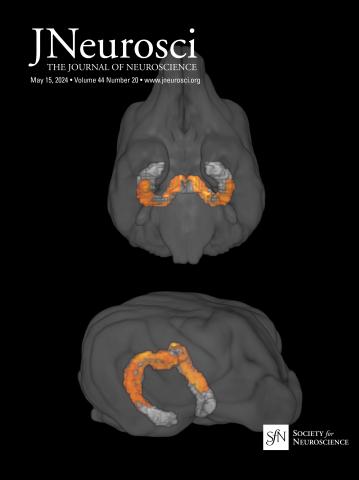Disrupted Neurogenesis from Basal Intermediate Precursor Cells Alters the Postnatal Neocortex in the TcMAC21 Mouse model of Down Syndrome.
IF 4
2区 医学
Q1 NEUROSCIENCES
引用次数: 0
Abstract
Cognitive, social behavior, speech, and motor skills are known challenges for people with trisomy 21/Down syndrome (DS) but the precise mechanisms that lead to these impactful changes have not yet been described. Data from human and mouse model fetal brains indicate that alterations in prenatal neurogenesis might account for the neurological phenotypes that manifest after birth. Here, we evaluated key features of cortical neurogenesis in the humanized mouse model of DS (TcMAC21 of undetermined sex) to test whether and how the presence of the human HSA21q transchromosome impacts cortical development. Brain growth measurements throughout the second half of gestation and at several periods of postnatal development show overall that the TcMAC21 brain phenotype is less severe than in other DS mouse models that have less genetic similarity to humans with DS. However, despite the lack of gross changes in brain growth, we uncovered a significant temporally limited neurogenesis defect at mid-gestation that correlates with long-lasting effects on neuronal dispersion and neuronal function in the neocortex. Using Cre/Lox mediated genetic fate mapping we discovered a transient reduction in neocortical basal intermediate neural precursors (bIPCs) and that bIPC neuronal progeny are under-represented in the superficial layers of the neocortex. This change in neuronal production is associated with cortical activity changes after birth. Altogether, our data isolate the cell types associated with a very specific temporal change in cortical formation that, due to the high levels of excitability of bIPC-derived neurons, creates lasting effects on network activity and circuit development in trisomic brains.Significance Statement This study, using a mouse model of Down syndrome (DS) with high genetic relevance to human trisomy 21, suggests that a specific population of excitatory neurons in the cerebral cortex is perturbed during fetal brain development. Production of these neurons, from a group of embryonic progenitor cells called basal intermediate progenitor cells (bIPCs), is decreased in mid-gestation, and the neurons successfully produced from intermediate progenitor cells (IPCs) show altered positioning in the mature cerebral cortex of the DS mouse brain. This change in neurogenesis likely contributes to altered connectivity and electrical activity in the DS brain.基础中间前体细胞神经发生中断改变唐氏综合征TcMAC21小鼠出生后新皮质
认知、社会行为、言语和运动技能是已知的21三体/唐氏综合征(DS)患者面临的挑战,但导致这些影响变化的确切机制尚未被描述。来自人类和小鼠胎儿大脑模型的数据表明,产前神经发生的改变可能解释了出生后出现的神经表型。在此,我们评估了人源化DS小鼠模型(TcMAC21性别未定)中皮质神经发生的关键特征,以测试人类HSA21q转染色体的存在是否以及如何影响皮质发育。整个妊娠后半期和出生后发育的几个时期的大脑生长测量总体上表明,TcMAC21的大脑表型比其他与患有DS的人类遗传相似性较低的DS小鼠模型的大脑表型要轻。然而,尽管大脑生长没有明显变化,但我们发现妊娠中期存在显著的暂时性神经发生缺陷,这与新皮层中神经元弥散和神经元功能的长期影响有关。利用Cre/Lox介导的遗传命运定位,我们发现新皮层基底中间神经前体(bIPC)的短暂减少,并且bIPC神经元的后代在新皮层的浅层中代表性不足。这种神经元生成的变化与出生后皮层活动的变化有关。总的来说,我们的数据分离了与皮层形成中非常特定的时间变化相关的细胞类型,由于bipc衍生的神经元的高水平兴奋性,对三体大脑的网络活动和回路发育产生了持久的影响。这项研究使用了与人类21三体具有高度遗传相关性的唐氏综合征(DS)小鼠模型,表明在胎儿大脑发育过程中,大脑皮层中特定的兴奋性神经元群受到干扰。这些神经元是由一组被称为基底中间祖细胞(bIPCs)的胚胎祖细胞产生的,在妊娠中期减少,并且由中间祖细胞(IPCs)成功产生的神经元在DS小鼠大脑成熟的大脑皮层中显示出位置的改变。这种神经发生的变化很可能导致了DS大脑连通性和电活动的改变。
本文章由计算机程序翻译,如有差异,请以英文原文为准。
求助全文
约1分钟内获得全文
求助全文
来源期刊

Journal of Neuroscience
医学-神经科学
CiteScore
9.30
自引率
3.80%
发文量
1164
审稿时长
12 months
期刊介绍:
JNeurosci (ISSN 0270-6474) is an official journal of the Society for Neuroscience. It is published weekly by the Society, fifty weeks a year, one volume a year. JNeurosci publishes papers on a broad range of topics of general interest to those working on the nervous system. Authors now have an Open Choice option for their published articles
 求助内容:
求助内容: 应助结果提醒方式:
应助结果提醒方式:


